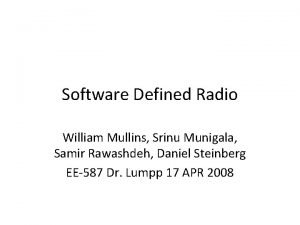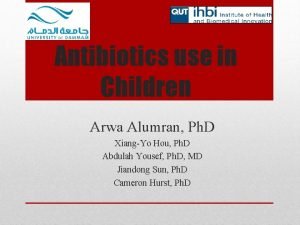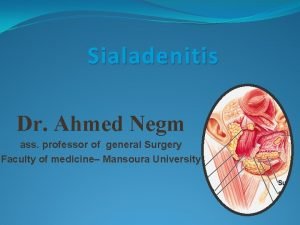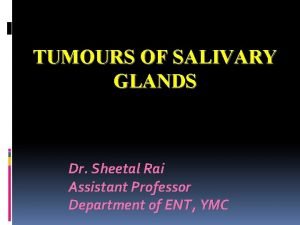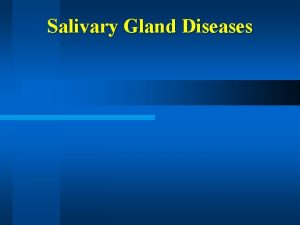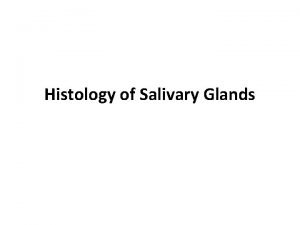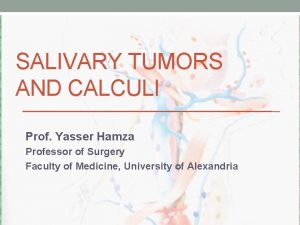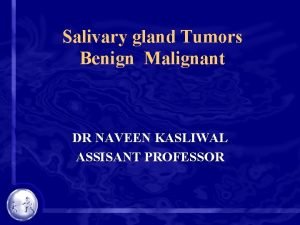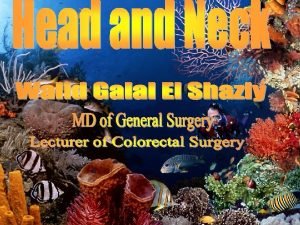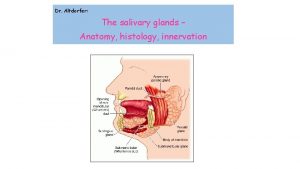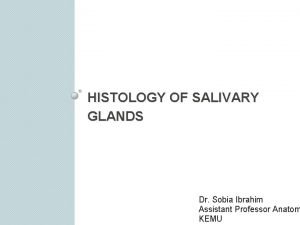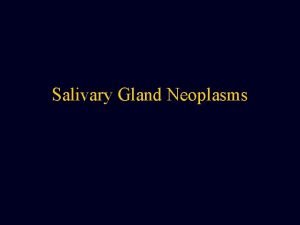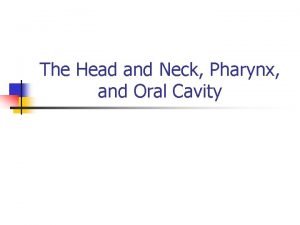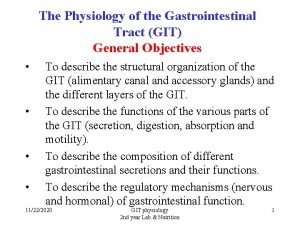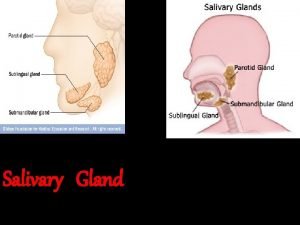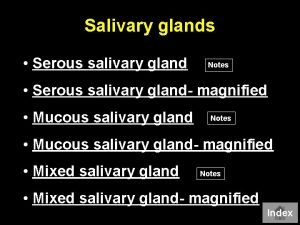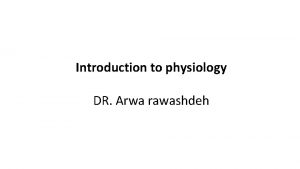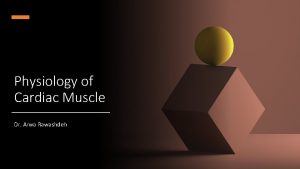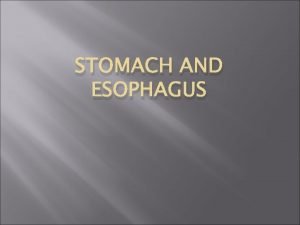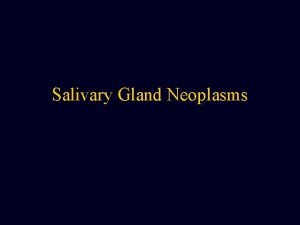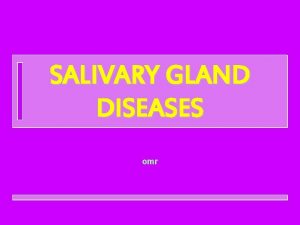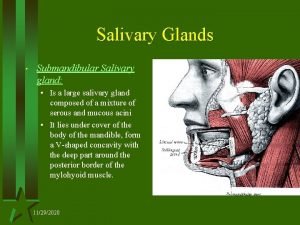Physiology of salivary gland esophagus Dr Arwa Rawashdeh













- Slides: 13

Physiology of salivary gland esophagus Dr. Arwa Rawashdeh

Main function of digestive system Provides the body with a supply of water, nutrients, electrolytes, vitamins. 1) Digestion of the food 2) Absorption of the products of digestion • 1) Digestive processes: Mechanical methods: • mastication (chewing) • - swallowing (deglutition) • - movements of the GIT • (motor functions) Chemical means (secretions): - saliva • - gastric juice • - pancreatic juice • - intestinal juice • - bile

PHYSIOLOGY OF MOUTH Mechanical activity – mastication • The anterior teeth – a cutting action • The posterior teeth – a grinding action • Thee maximal closing force - incissors 15 kg • - mollars 50 kg Function of the mastication: - grinding the food - mixing with saliva - makes easy swallowing aids subsequent digestion

• • • The salivary galnd The salivary glands: Parotid Submandibular Sublingual Buccal • Secretion of the saliva: - basal - 800 – 1500 ml/day Produce 1. 0– 1. 5 liters of saliva each day • - during intake of food

Composition of the saliva • 99. 5�% water, mucus, white blood cells, epithelial cells (from which DNA can be extracted), enzymes (such as amylase and lipase), antimicrobial agents such as secretory Ig. A and lysozyme • Anorganic substances: Na+, K+, Cl-, HCO 3 Functions of saliva • Keeps the mouth moist, aids speech • Facilitates swallowing • Serves as a solvent for the molecules that stimulate the taste buds • Serves a solvent for irritating foods - helps wash away the pathogenetic bacteria Keeps the mouth and teeth clean Deficient salivation = xerostomia

Pavlov's Dogs Unconditioned reflexes: Taste and tactile stimuli increase 8 -20 times the basal rate of secretion Conditioned reflexes: Visual, olfactorey , acoustic stimuli

Regulation of salivary secretion Sympathetic Innervation • The sympathetic control of salivary production is via the superior cervical ganglion. Sympathetic stimulation results in the release of noradrenaline, which acts upon alpha- and beta-adrenergic receptors. • This results in the following effects: • Decreased production of saliva by acinar cells • Increased protein secretion • Decreased blood flow to the glands • There is variable sympathetic innervation between the salivary glands. On the whole, this system is far less important than the parasympathetic innervation in terms of regulating production of saliva. Parasympathetic Innervation • The parasympathetic outflow is coordinated via centres in the medulla, and innervation occurs via the facial and glossopharyngeal nerves. Afferent information from the mouth, tongue, nose and conditioned reflexes are integrated within the brain – and in the presence of food, parasympathetic stimulation occurs. • Parasympathetic outflow results in the release of acetylcholine (ACh) onto M 3 muscarinic receptors. This results in the following effects: • Acinar cells increase secretion of saliva • Duct cells increase HCO 3– secretion • Co-transmitters result in increased blood flow to the salivary glands • Contraction of myoepithelium to increase the rate of expulsion of saliva • Overall, increased parasympathetic stimulation results in an increased flow of saliva that is more watery in composition. • • • Centers: salivary nuclei (at the juncture of the medulla and pons): superior – submandibular (70%), sublingual (5%) inferior – parotid (serous saliva)

Exchange of sodium and potassium in salivary gland Saliva is produced by the salivary glands of body – the parotid, submandibular and sublingual glands. Within the glands, the acinar cells are responsible for the volume of saliva secreted, and the duct cells are responsible for the composition of saliva. Because sodium is absorbed in excess, chloride ions follow the electrical gradient causing chloride levels in saliva to decrease greatly. Bicarbonate ions are secreted by an active transport process causing an elevation of bicarbonate concentration in saliva. The net result is that, under basal conditions, sodium and chloride concentrations in saliva are about 10% to 15% of that of plasma, bicarbonate concentration is about threefold greater than that of plasma, and potassium concentration is about seven times greater than that of plasma. actual concentration of bicarbonate in saliva is 50 to 70 m. Eq/L, whereas the concentration of potassium is about 30 m. Eq/L, under basal conditions

Transepithelial Transport: Summary MEMBRANE TRANSPORT PROTEINS drive TRANSCELLULAR transport of ions, which sets up ELECTROCHEMICAL GRADIENT to allow PARACELLULAR transport of fluid through TIGHT JUNCTIONS mucous layer Transcellular Sets u gradi p electroc ents hemic al Paracellular

Swallowing (Deglutition) Three stages: 1) oral – voluntary – the food is squeezed into the pharynx by tongue 2) pharyngeal – automatic – cannot be stopped (1 s) Involuntary contraction in the pharyngeal muscles – that pushes the food into the oesophagus. Concomitant actions: Inhibition of respiration, closing of the posterior nares by the soft palate, pulling the larynx upward (enlargement the opening of the oesophagus), glottic closure 3) oesophageal the first third striated muscle the last third smooth muscle the middle – mixed -Function – to transport food from the pharynx to the stomach by gravity and by peristalsis Peristalsis – primary = a continuation of the peristaltic wave from pharynx - secondary waves result from distention of the oesophagus by the retained food. Speed 4 cm/s The swallowing time – for a compact food 6 -9 s a fluid 4 -5 s


Regulation of the oesophageal peristalsis - by intrinsic neural circuits – myenteric and submucosal plexus - by vagal efferent fibers

Disorders of the swallowing - dysphagia – pain achalasia – weak oesoph. peristalsis, accumulation of the food in the oesophagus – dilatation, increased tonus of cardiae. lower oes. sphincter incompetence – gastrooesophageal reflux (GER). Surgical treatment
